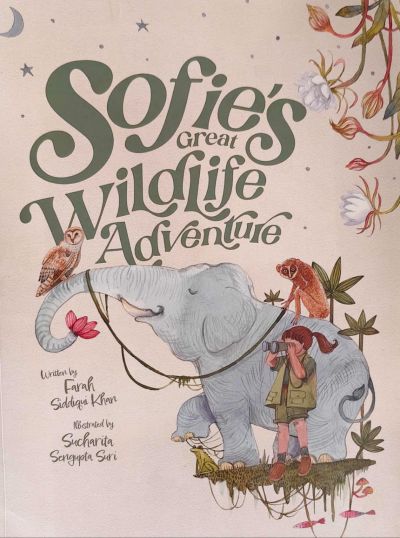
Elephant Family Foundation India’s latest outreach connects children with nature through imagination writes Autar Nehru
Mumbai-based art curator Farah Siddiqui Khan, chairperson of Elephant Family Foundation India (EFFI) — a nonprofit Section 8 company and the Indian affiliate of Elephant Family UK — has released her first children’s book titled “Sofie’s Great Wildlife Adventure.”
The richly illustrated book, aimed at children up to Class 4, tells the story of Sofie’s visit to a wildlife sanctuary organized by her school. Guided by her mother, Sofie learns about wildlife etiquette, conservation, and how to respectfully experience nature. Interestingly, the book’s protagonist is inspired by Khan’s own seven-year-old daughter, also named Sofie.
“I always wanted to write a story for her. And given my own interest in wildlife and our work at EFFI, we combined both passions to create this book,” says Khan.
Illustrated by Sucharita Sengupta Suri, the book is not for sale. Instead, it has been produced as part of EFFI’s educational and awareness-building initiatives and is being distributed free of cost to schools. The foundation encourages schools to include the book in their library collections to reach as many children as possible.
“Primary school headmistresses and supervisors can reach out to us for copies, and we’ll send them across. In the first edition, we’ve printed 1,500 books, and as demand grows, we’ll print more,” Khan adds.
Along with the book, EFFI provides worksheets so teachers can read the story aloud in class. Children then complete a simple jigsaw awareness cum conservation puzzle activity reinforcing the book’s lessons. “Several schools are inviting me for reading sessions, and we hope to continue this engagement,” Khan shares.
Sofie’s Great Wildlife Adventure follows a curious young girl preparing for her first visit to a wildlife sanctuary. Through her mother’s gentle guidance, she learns about:
- Respecting animal habitats
- The importance of not littering
- Proper behavior while visiting the wild
- How every creature, big or small, plays a vital role in the ecosystem
Filled with humor, simple facts, and lush illustrations, the book nurtures empathy for animals and appreciation for India’s biodiversity.
Khan’s involvement with conservation began during Elephant Parade India (2018) — a public art and awareness campaign graced by then-Prince (now King) Charles. The event inspired her to extend Elephant Family’s mission in India and use storytelling as a tool for conservation education. She also had a family association with forests where her father owned a forest in UP’s Gorakhpur.
“Storytelling naturally builds empathy and values,” she explains. “Through stories, we can teach children kindness, patience, and respect for wildlife. Today’s generation, often glued to screens, needs to rediscover the joy of nature and the importance of coexisting with all living beings.”
Khan emphasizes that wildlife tourism should be responsible and respectful:
“It’s about being kind, sharing space, and simply observing animals without disturbing them. They may look adorable, but they are not pets. Don’t clap, call out, or try to get their attention. Just watch quietly, take photos, and cherish the experience.”
The Foundation’s Broader Mission
EFFI’s mission is to support on-ground conservation efforts, especially those addressing human-animal conflict and promoting coexistence. It is involved in a project on conservation of Asian elephants where it supports both the conservation scientists and local communities Through education, outreach, and creative initiatives like this book, the foundation hopes to inspire the next generation to continue this vital work.
“An educational storybook can truly make an impact — preparing children to become thoughtful custodians of the environment,” says Khan.
In her foreword to the book, noted naturalist Ratna Singh writes:
“India’s jungles are ancient and alive — from the stripes of a tiger to the silent glide of an owl, or the winged termites that emerge after a rain shower to start new colonies. Every creature is a thread in the beautiful tapestry of the wild. The ethos of respect and coexistence celebrated in this book are the very reasons we still have this incredible natural heritage.”
Looking Ahead
While a second edition has not yet been finalized, Khan hints at possible future adventures:
“We may take Sofie to an ocean sanctuary next — to introduce children to the wonders of marine life and conservation.”
Broader Conservation Challenges
Khan also points out the growing challenges in elephant and wildlife conservation across India.
“Animals are increasingly straying into villages and towns; tigers are found scavenging garbage. Rapid infrastructure development like road construction is fragmenting habitats. We need better planning, community engagement, and respect for traditional ecological wisdom.”
She adds,
“Animals have always been part of our folklore and Hindu mythology. Hinduism teaches coexistence — and that philosophy should guide our approach to both development and conservation.”










